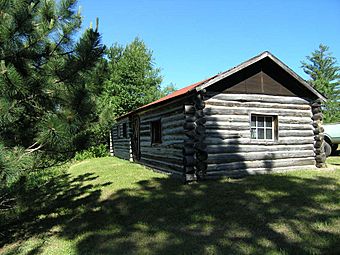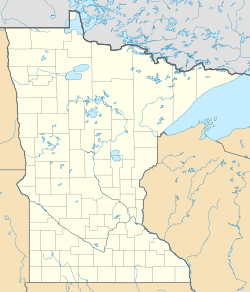Kettle Falls Historic District facts for kids
Quick facts for kids |
|
|
Kettle Falls Historic District
|
|

The Dam Keeper's Cabin in the Kettle Falls Historic District
|
|
| Location | Kettle Channel in Voyageurs National Park |
|---|---|
| Area | 29 acres (12 ha) |
| Built | c. 1910–1914 |
| NRHP reference No. | 78000376 |
| Added to NRHP | July 17, 1978 |
The Kettle Falls Historic District is a special place with old buildings and history, deep in the wild Boundary Waters area. It's located in what is now Voyageurs National Park in Minnesota. Kettle Falls is where water flows from Namakan Lake into Rainy Lake, right on the Canada–United States border.
This area was a very important meeting spot for a long time. Early French-Canadian travelers called voyageurs used it, and later, miners, fishermen, and loggers came here in the early 1900s. Tourists started visiting in the 1930s. The Kettle Falls Dam was built here between 1910 and 1914. Two log buildings from that time are still standing. Another important building in the historic district is the Kettle Falls Hotel, which was built in 1913.
In 1978, the Kettle Falls Historic District was added to the National Register of Historic Places. It was recognized for its importance in trade, engineering, industry, and transportation. It's special because it was a busy center for work and tourism in a very wild area.
History of Kettle Falls
The trail at Kettle Falls was first known as the portage de Chaudière. A "portage" is a place where people carry their boats and goods over land between two bodies of water. This trail was often used by fur traders. It later became part of the border between Canada and the U.S.
In the 1890s, a "gold rush" brought many miners through the area, hoping to find gold. Later, the Kettle Falls area was used by people who fished for business and by loggers. Commercial fishing camps operated here from 1913 to 1920. By the 1930s, logging was the main activity.
The Kettle Falls Dam
The dam at Kettle Falls is about 20 feet (6.1 m) tall. It has four channels, or "sluiceways," for water to flow through. One part of the dam is called the American Dam, and the other part, on the Canadian side, is called the International Dam. The dam used to have special "fish ladders" to help fish swim past it, but these no longer work.



